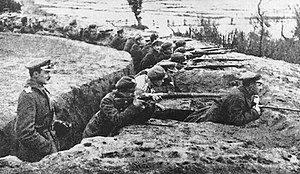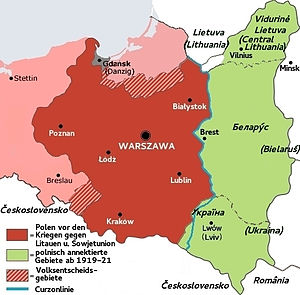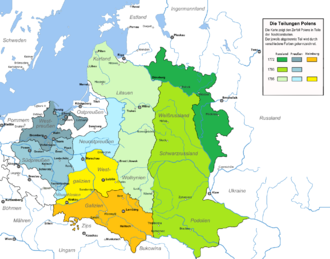Polish–Soviet War
Polish-Soviet War

Polish trench in the Battle of the Memel, September 1920
In the Polish-Soviet War of 1919 to 1921 (Russian Советско-польская война/ transcription: Sovetsko-polskaja woina, Polish Wojna polsko-bolszewicka, Ukrainian Польсько-радянська війна Polsko-radjanska wijna), on the one hand, Poland, re-established in 1918, attempted to restore in the east the historical borderline of 1772 and to create an Eastern European confederation (→ Międzymorze) under Polish leadership. Soviet Russia, on the other hand, still engaged in civil war, was eager to extend its sphere of influence to the West. In Ukraine, Poland was supported by nationalist forces that had previously been driven from power by the Bolsheviks.
The initial successes of the Polish troops under Marshal Piłsudski and the foreign military units supporting them, which were able to occupy large swathes of Ukraine, including Kiev, were undone by the Soviet Red Army after some time: it threw the Polish army so far back into the interior of Poland that an occupation of Poland was threatened. At the Battle of Warsaw, the Polish Army was again able to turn the tide. In subsequent campaigns, the Soviet army was pushed back as far as Ukraine. In addition, in the Polish-Lithuanian War in October 1920, the area around the Lithuanian capital Vilnius (Polish: Wilno) was conquered.
In the Treaty of Riga, signed on 18 March 1921, Soviet Russia, Soviet Ukraine and the Republic of Poland agreed to accept the armistice of the previous year and the course of the border between the Soviet Union and the re-established Polish state, as well as to pay compensation, among other things. The Polish-Soviet border now ran in places up to 250 km east of the line that a commission had proposed in 1919 as the eastern border of the re-established Poland ("Curzon Line"). The agreement was the second treaty "territorial amputation" of ethnically non-Russian territory after the October Revolution, which had previously been considered by Tsarist Russia as an integral part of its own national territory.

Curzon Line and Polish Land Gains through War and Treaties 1919-22
Causes
Russia, which had withdrawn from the First World War as a result of the October Revolution, did not take part in the Paris negotiations on the post-war order, which is why a border settlement between the newly founded Republic of Poland and Soviet Russia, now led by the Communist Bolsheviks, was not reached there.
Bolshevik Russia, which was in the throes of civil war, was eager to shift its sphere of influence to the West and trigger a proletarian revolution in Germany.
Poland, in turn, tried to maintain its regained independence and to strengthen its own position of power on its eastern flank. There was no consensus in Polish politics about the desired border with Soviet Russia. Marshal Piłsudski, who commanded the Polish armed forces, strove for a sphere of influence extending as far east as possible in the form of an East European confederation under Polish leadership. The course of the eastern border of Poland-Lithuania on the eve of the partitions of Poland (1772) served as a reference.
A complete independence of Ukraine and Belarus, which was partly sought by the latter, was ruled out according to both Polish and Russian war aims. In Ukraine, Poland was nevertheless supported by national forces that had previously been deposed by the Bolsheviks.
The exact date of the beginning and the trigger of the war are unclear and disputed. Some authors refer to the Polish attack on Kiev (April 1920) as the beginning of the war. Others place the start of the war in 1919. Since the war was preceded by a simmering border conflict, both views have merit. It is also disputed whether the end of the war should be dated to the armistice on 18 October 1920 or to the conclusion of peace in Riga on 18 March 1921.
The Polish-Ukrainian alliance of April 1920, following the Polish-Ukrainian War, shifted the weight of the parties involved during the course of the war.
Initial Situation
The First World War had fundamentally changed the political map of eastern Central Europe and Eastern Europe. The disintegration of the Russian Empire in the wake of its defeat in the October Revolution and the demise of Austria-Hungary left room for new nation states. Along with Finland, Estonia, Latvia, Lithuania, and Czechoslovakia, Poland also successfully took the step toward statehood. After the partitions of Poland in 1772, 1793 and 1795, a Polish state did not exist at first. However, in the areas that had belonged to Poland until 1772, a number of other ethnic groups (White Russians, Ukrainians, Kashubs, Germans, etc.) lived alongside Poles anyway. The Poles had always maintained a cultural independence, but the problem of Poland's borders became directly apparent with the new or resurgent nation-states. This had already manifested itself during the World War. The German Empire had attempted to exploit these tendencies for its own benefit by establishing a pro forma independent Kingdom of Poland. After the armistice on the Western Front, Poland declared itself independent on November 11, 1918. Under pressure from the Entente powers, among others, Poland's status as an independent nation-state was recognized by Austria in 1918 and by the Weimar Republic in 1919 in the Paris Suburb Treaties. The Western allies established a provisional border demarcation with the Curzon Line, which avoided placing a number of non-Polish ethnic groups under Polish rule, but in turn excluded many Poles from their nation-state. Poland itself, due to the effects of the First World War, was in economic crisis. It received help from an American relief mission under Herbert Hoover. The re-establishment of the Polish state was not complete by the end of the war. Although there was already a new stable currency, for example, the new administration had not yet taken hold everywhere. In the years to come, the military would prove to be the most powerful instrument of the Polish state's policy.
The Bolsheviks viewed Poland as a state controlled by the Entente and saw it as the bridge to Europe on which the revolution would be carried westward. On the whole, the prevailing view in Russia was that the newly independent states of East Central and Eastern Europe were rebellious Russian provinces, so that even the opponents of the Bolsheviks in the Civil War, the White Guards, denied sovereignty to Poland and the other states of this region and strove for a restoration of Russia within the borders of the Tsarist Empire. Russia was in civil war at this time. The White Armies were attempting to oust the Bolsheviks from their position of power and restore the Russian dominated multi-ethnic state. The country itself was plagued by economic decline and supply problems. The losses among the population due to fighting and disease are estimated to be as high as eight million.

Poland in the borders of 1771 and the partitions of the I. Republic in the years 1772, 1793 and 1795
Search within the encyclopedia